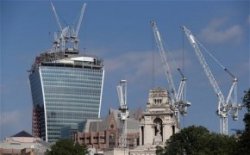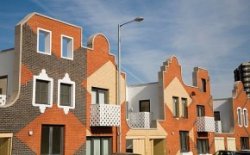Domestic Architectural
 This is weird when you think about it. London was the world’s first megacity. Britain urbanised before any other country and we came up with a fantastic innovation to deal with this: terraced housing. The Georgian and Victorian terraces in our cities are a modest wonder of the world. They range from the palaces around Regent’s Park to the handsome Georgian rows of Islington to the workers’ cottages near Waterloo and are some of the very best high-density housing there is. However, mass urban housing is a bit like football. We may have invented it, and we often hark back to how good we used to be at it. But almost every other country in Europe is now better at it than we are.
This is weird when you think about it. London was the world’s first megacity. Britain urbanised before any other country and we came up with a fantastic innovation to deal with this: terraced housing. The Georgian and Victorian terraces in our cities are a modest wonder of the world. They range from the palaces around Regent’s Park to the handsome Georgian rows of Islington to the workers’ cottages near Waterloo and are some of the very best high-density housing there is. However, mass urban housing is a bit like football. We may have invented it, and we often hark back to how good we used to be at it. But almost every other country in Europe is now better at it than we are.
So what went wrong? I think our problems started with the Garden City movement. The garden cities were a reaction to the overcrowded, polluted slums of the 19th century. At the time, they were the right reaction and their spacious houses with gardens were, literally a breath of fresh air. But that was over 100 years ago. Today it’s as if we retain some indelible folk memory of the Hogarthian slums, even though we know that houses in some parts of the capital routinely change hands for £2.5 million. This might help explain why, earlier this year, Nick Clegg announced three new Garden Cities, to house all of 45, 000 people, a fraction of the shortfall in London alone.
The idea that Garden Cities (which are low density by nature) are the solution to our problems is indicative of the mixture of cognitive dissonance, misty-eyed nostalgia and the ability to consistently learn the wrong lessons that has characterised UK housing for the last 50 years.
In the '50s and '60s, many of our city neighbourhoods had been damaged by bombs and badly neglected. So, instead of restoring them and rebuilding houses, we flattened many of them (citing reasons like outside toilets) and destroyed communities. The idea was that they’d be replaced by clean and modern flats, set in parkland. The parkland soon became a wasteland, the buildings were built on the cheap (and often not to the architects’ specifications) and the much vaunted indoor toilets didn’t matter because, pretty soon, everyone was urinating in the lifts.
20 Fenchurch Street, London: the 'Walkie Talkie' (Photo: Getty Images)
So we learned the wrong lesson. Instead of building better high-rises with a sense of community and quality amenities like they do in places like New York and Singapore, we decided that high rises were inhuman or fit only for the poor, despite abundant evidence to the contrary. Yes, we started building on a more human scale, but we became terrified of tall buildings and big ideas. We became so backward-looking and timid that Prince Charles become a serious voice in British architecture.
 The result is some of the world’s worst architecture. An exemplar of this is much of the '80s housing that covers the old docks in Rotherhithe. It’s bizarre. In inner Zone 2, closer to the centre of London than Canary Wharf, you have a kind of giant Brookside Close. A mini Milton Keynes, a maze of two-storey toytown houses in cul-de-sacs with wasted space everywhere. Needless to say, the developers also built a giant shopping centre with acres of parking that is like a little slice of Stevenage in London.
The result is some of the world’s worst architecture. An exemplar of this is much of the '80s housing that covers the old docks in Rotherhithe. It’s bizarre. In inner Zone 2, closer to the centre of London than Canary Wharf, you have a kind of giant Brookside Close. A mini Milton Keynes, a maze of two-storey toytown houses in cul-de-sacs with wasted space everywhere. Needless to say, the developers also built a giant shopping centre with acres of parking that is like a little slice of Stevenage in London.
Rotherhithe is particularly glaring as it sits near the centre of London. But these dreadful developments are repeated on the outskirts of every town from Land’s End to John O’Groats. Mean little brick boxes dotted around dead end streets with no shops or amenities. It’s not just the layout either, it’s the quality. Outside, you’ll have crap bricks, crap concrete tiles, crap plastic windows and crap detailing. Enter through the PVC door with its twee Edwardian glass, noting the plastic carriage lamp. The hallways will have cottage height ceilings, with a faux Victorian staircase and stunted Georgian skirting boards made of MDF. The living room will boast a fire surround that apes some period between 1720 and 1920 and looks like it was made on a 3D printer. And so on.
They could so easily be so much better. Small modern houses are similar in square footage to many Victorian terraces. But it’s all in the detailing and the quality. The Victorian terraces will have high ceilings that make small rooms feel spacious. They’ll have proper sash windows. They’ll have ornate cornicing. They’ll have those funny, 12-inch skirting boards that give even 11-foot square front rooms a feeling of grandeur. It’s the little things that make little houses liveable.
The Victorians were volume house builders too. Much more so than we are. They built most of London’s suburbs and they did it speculatively and for profit. Yet somehow they managed to do it using beautiful, durable materials. The houses they built were often streets of clones or a couple of variations on a theme, but they had a sense of style to them and they used mass produced fittings like ornate cast-iron fire surrounds and plaster ceiling roses, not polystyrene coving and white PVC trim. This, in a nutshell is what is wrong with most of the UK’s new houses. They’re not just fakes: they’re bad, cheap fakes.
Islington Square, part of New Islington, in Manchester (Photo:Len Grant)
The new flats we build are slightly better. They are, at least recognisably modern. But in London they are all the same. Here, there’s a kind of Lego box with about six pieces in it. These are yellow London brick, render, wood cladding, grey steelwork and windows and planting. It’s OK – there’s not much to hate and it blends fairly unobtrusively with older architecture - but it’s just so timid. Where’s the flair? Where’s the imagination? When the Victorians started building their Gothic flights of fancy, they didn’t say, “Well, I suppose we’d better tone it down so it doesn’t clash with the Regency houses down the road.”
Of course, not all domestic architecture is hideous or dull. There’s the which is modest in size, dense and echoes the nearby terraces in scale and form while being modern and different. There are the high-tech houses that were built as part of the Sainsbury’s development in Camden in 1988. There are parts of Wapping and the of Dulwich. And there’s the crazy exuberance of the terraces that FAT built in. Look, too, on the sales website the . The UK is dotted with decent modern architecture.
But dotted is all it is – and these dots stand out as good deeds in a cheap and mediocre world. We celebrate them and the chattering classes love them (though often from the safety of their Victorian townhouses) and then we go and build another 50, 000 brick boxes with plastic Victorian detailing.






